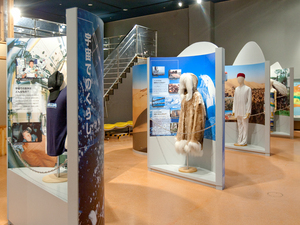Nagoya City Science Museum
TOP > Exhibition Guide > Floor Map> Environment and Our Lives
Environment and Our Lives



Purpose of Exhibition
There are no animals that inhabit such diverse environments as humans do. By comparison with other animals, humans have by far the better ability to adapt themselves to or change their environments. Wisdom to cope with a stern environment can be seen in people's life. We can find various ways of life adapted to the environments of places in clothing, foods, dwellings and so on.
Additional Knowledge
Life in tundraTundra is in such an environment that temperature does not rise above zero throughout the year and ice seldom thaws. Because of such climatic conditions, permafrost prevails in tundra. In summer, moss grows, but no grass or trees.
Because it is such a cold place, protection against the cold is very important. Anoraks are known well as Inuit's traditional winter clothes. They are made of seal skin and reindeer fur and equipped with hoods. Please experience a feel of seal skin by all means. Their clothes are made of seal skin mostly, including not only outerwear but also gloves and underwear.
They build houses with snow called igloos. They cut snow like bricks and pile them up like a dome. Although it looks cold, it is quite warm inside as it provides protection from cold winds blowing outside, besides its semi-spherical form, which keeps the surface area small and helps contain heat inside. During summer when snow thaws, they are busy with hunting and live in tents made of seal skin called Tupik.
It is hard to secure food. Small populations of animals provide their subsistence. Inuit living in Canada live on seal and walrus flesh.
Life in a desertClimatic conditions of a desert are characterized by little rain (250 mm or less annual precipitation), low humidity, and large temperature difference between the morning and the daytime. For organisms, the scarcity of water alone makes the environment a very harsh one to live in. For this reason, the places where people can live are found only in the vicinities of oases or wells where groundwater springs.
People dwelling in a desert wear loose, long dresses covering their entire bodies. They may look hot, but they protect bodies from intensive sunlight and heat and prevent dehydration. Hats and veils protect faces from a sandstorm and strong sunlight.
It is important to provide sufficient heat insulation to prevent an inflow of heat in the daytime and contain heat in the nighttime to keep warm inside. So their houses are made of readily available soil or adobe, which is bricks made of sun-dried soil. Making windows small and closing doors will shut off hot winds and strong sunlight outdoors, providing a cool, livable environment for people. During the nighttime, on the other hand, outdoor temperature falls considerably, so they open doors and windows to free heated hot air from the inside.
People eat flesh and milk of cattle such as sheep and goats as their staple food. Yogurt and butter is also produced. They also eat grain such as millet obtained through trading. In the case of nomads, they hunt games and eat animal flesh.
Life in a jungleThe climate is hot and humid throughout the year. Although temperature does not change much throughout the year, precipitations differ by season, often making the distinct rain and dry seasons. During the daytime, it gets stiflingly hot with little winds and they often have torrential rains (squall) in the afternoon. The land is covered with dense, evergreen broadleaf forests, which are replete with diverse organisms so rich in species as more than half the species living on the earth are found there. The Amazon river basin in South America, the Congo river basin in Africa and Indonesia are typical tropical rainforest regions.
People living in tropical rainforests usually cover their bodies with tree barks or leaves, but nothing that can be called garments in our sense. In hot, humid tropical rainforests, they do not need to wear clothes except on special occasions such as a ritual.
Their houses made of wood, grass and leaves are designed to ensure good ventilation to prevent the interior from getting hot. They build houses on elevated floors to prevent them from getting damp or with larger, extended roofs to prevent rain from entering.
In a jungle (tropical rainforest) replete with organisms, foods are abundant. They can obtain everything from flesh and fish to grain and nuts through hunting, collection and agriculture, though kinds of foods available vary from one region to another.
Life in spaceIn recent years, humans are also advancing into space. Naturally, we cannot find air or gravity in space. The place where sunbeams hit reaches quite a high temperature, while it gets very cold in the shadow. In addition, ultraviolet rays and cosmic rays harmful to organisms are plenty and micro-meteors are flying at high speeds. Of course, it is the severe environment that does not allow organisms to survive.
A living environment in a spaceship and space station is conditioned, so that people dress similarly as they are on the earth or rather lightly to place emphasis on the ease of activity. However, they cannot go out into space in such attire. They have to wear spacesuits to work in space and flight suits at the time of lift-off and return to the earth.
A spacesuit must provide the functions that protect a body from radiation, micro-meteors, vacuum and an extremely low temperature.
Article by Chieko Osaka, curator
